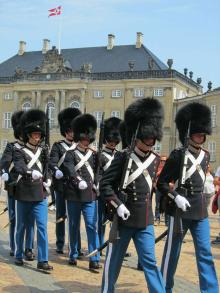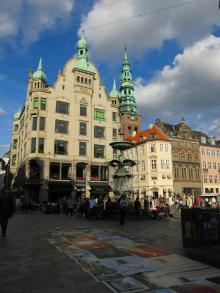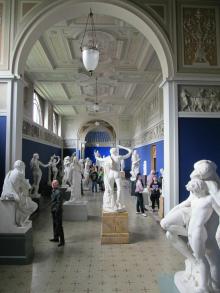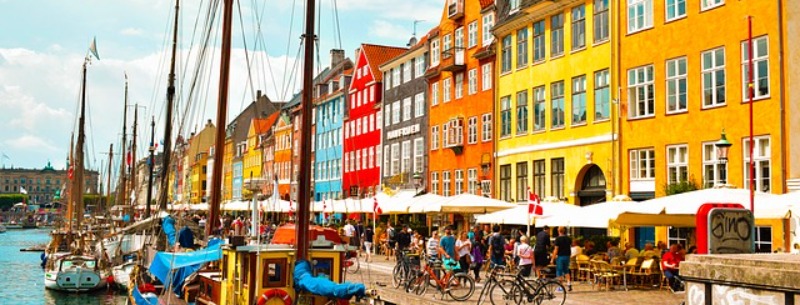Copenhagen, Denmark is an incredible city with lots to offer, from the traditional to the modern – historic palaces and gardens, vibrant neighborhoods, renowned restaurants, and a multitude of green spaces. It’s known for its colorful buildings, love of bicycles, and something less endearing – its high prices. Copenhagen is one of the most expensive cities in Europe, and visiting from abroad can seem daunting when you realize that a coffee averages about $8. But Copenhagen is also a city with lots to see and explore without spending all of your holiday cash. Here are eight ways you can enjoy Copenhagen without breaking the bank.
Walk the Waterfront from Nyhavn to the Little Mermaid
Copenhagen’s two most famous attractions are free! The city is perhaps best known for its Nyhavn canal, lined with colorful historic buildings now housing restaurants and cafes. Of course, these are not the places to eat or drink if you’re on a budget (a glass of Coke can run you upwards of $10!), but the Nyhavn canal is a nice place to stroll along and soak up the atmosphere.
 It can be very crowded in the summer months, so I’d recommend walking along the opposite side, which also is a better viewpoint for photos. Continuing along past the end of Nyhavn, you will reach the main canal, with a view of the Opera House. Strolling along the waterfront, you will pass Amalienborg Palace, the gorgeous Gefion Fountain, and the Kastellet Fortress (also free to explore) before reaching the iconic Little Mermaid. Also a busy tourist spot, you may have to be patient to get that perfect photo, but it is possible and worth the wait!
It can be very crowded in the summer months, so I’d recommend walking along the opposite side, which also is a better viewpoint for photos. Continuing along past the end of Nyhavn, you will reach the main canal, with a view of the Opera House. Strolling along the waterfront, you will pass Amalienborg Palace, the gorgeous Gefion Fountain, and the Kastellet Fortress (also free to explore) before reaching the iconic Little Mermaid. Also a busy tourist spot, you may have to be patient to get that perfect photo, but it is possible and worth the wait!
See the Changing of the Guard
Every day at noon, the Changing of the Guard takes places at Amalienborg Palace, home of the Danish Royal Family, and it’s a great experience. As the clock chimes twelve, the rows of replacement guards appear as an eager crowd gathers to watch the spectacle. Admittedly, after the initial excitement of the soldiers emerging from the palace, there is a lot of standing around.
 But it’s worth the wait to see the carefully choreographed sequences as the soldiers march in unison in their smart navy uniforms and distinctive furry helmets. One by one, each guard is relieved from his post as a replacement takes up the watch. Many tourists get impatient and leave after seeing the initial march and getting their photo op at a distance. But if you stick around and actually watch the soldiers make their way to each post around the square, you can see the guards up close, and get fantastic pictures.
But it’s worth the wait to see the carefully choreographed sequences as the soldiers march in unison in their smart navy uniforms and distinctive furry helmets. One by one, each guard is relieved from his post as a replacement takes up the watch. Many tourists get impatient and leave after seeing the initial march and getting their photo op at a distance. But if you stick around and actually watch the soldiers make their way to each post around the square, you can see the guards up close, and get fantastic pictures.
Wander the Strøget
At over a mile in length, the Strøget is the longest pedestrian street in the world and it’s a great place to explore. It runs from Kongens Nytorv (Kings Square) next to Nyhavn, to Rådhuspladsen – City Hall Square. Though it’s a shopping street, the Strøget has more to offer, with historic buildings, squares and fountains including the gorgeous Stork Fountain. From there you’ll find Christiansborg Palace in one direction, and Rundetaarn (the Round Church) in the other.
 The main church of the Rundetaarn is free to enter, though it costs 25 DKK (about $5) to climb the 500 steps of the Round Tower to incredible views of the city. City Hall Square often hosts various community events, and the Rådhus itself is an impressive building. You can enter the attractive lobby and view the World Clock, an achievement in timekeeping. Next to the Rådhus is the statue of author Hans Christian Andersen, gazing at Tivoli Gardens across the street named for him.
The main church of the Rundetaarn is free to enter, though it costs 25 DKK (about $5) to climb the 500 steps of the Round Tower to incredible views of the city. City Hall Square often hosts various community events, and the Rådhus itself is an impressive building. You can enter the attractive lobby and view the World Clock, an achievement in timekeeping. Next to the Rådhus is the statue of author Hans Christian Andersen, gazing at Tivoli Gardens across the street named for him.
Cross the Bridge to Christianhavn
Just across the canal from the city center is the burough of Christianshavn. Set a bit away from the hustle and bustle of the tourist spots, and with a feel all its own, there is lots to see here without having to spend. Christianshavn has its own small canal, filled with leisure boats and lined with colorful buildings and cafes. The most well-known site here is the Church of Our Saviour, famed for its spiral tower, but whose stunning wooden interior is also worth a visit. Though the spire costs 45DKK to climb (about $9), entry to the church itself is free.
The beautifully colored alter is lined with life-sized statues of angels, facing the massive wooden organ held up by carved elephants. There is a golden baptismal and carvings in the ceiling, and the lighting is fantastic when the sun streams in the large windows. Just a few minutes walk from the church is the freetown of Christiana, which was established in 1971 when squatters took over an abandoned military barracks. A commune of 850 residents, Christiania is governed by its own unique laws. There are shops, cafes, and even concerts held inside, but Christiania is most famous for its marijuana trade, even though it is still illegal there. It’s an interesting place to visit, but not for the easily intimidated, as the atmosphere is a bit unsettling and there are strict rules when it comes to visitors. Even so, it’s worth a look, just to see a non-traditional way of living.
Visit Museums and Galleries
The Danish National Museum and the National Art Museum are both free to enter and are the perfect place to spend a day, especially in cold or rainy weather. The Ny Carlsberg Glyptotek was founded by Carl Jacobsen, of the Carlsberg Breweries and is housed in a stunning building just behind Tivoli Gardens.
 The Glyptotek is free on Sundays, and boasts a stunning collection of statues, paintings, and artifacts. Centered around a Winter Garden featuring palm trees and a fountain, the Glyptotek spans three floors and contains endless works of art. You can see everything from Roman and Egyptian artifacts to sculptures by Rodin and impressionist paintings by the likes of Dugas, Monet, and Van Gogh.
The Glyptotek is free on Sundays, and boasts a stunning collection of statues, paintings, and artifacts. Centered around a Winter Garden featuring palm trees and a fountain, the Glyptotek spans three floors and contains endless works of art. You can see everything from Roman and Egyptian artifacts to sculptures by Rodin and impressionist paintings by the likes of Dugas, Monet, and Van Gogh.
Explore the Torvehallerne Food Hall
Torvehallerne sits just behind the Norreport Station, and is a great place to wander and indulge your senses. It consists of two main buildings, with an outdoor fruit and vegetable market in between. Torvehallerne features ready-to-eat foods, as well as locally produced meats, cheeses, seafoods, and gourmet items like chocolates, jams, and spices. There are several coffee shops and places to sit for a bite, however these will run you the standard Copenhagen prices, or more. You can find a couple of delicious bargains though, like at the Thai food stand or the taco truck, both outside in the courtyard, and you can pick up some fresh local fruit to snack on as you explore the city.
Enjoy the Parks and Gardens
Copenhagen is bursting with green spaces, with a multitude of parks and gardens to enjoy. The Botanical Gardens and the Kings Gardens surrounding Rosenborg Castle are lovely places for a stroll, and every neighbourhood has its own park, where residents come in the nice weather to jog, barbeque, or just relax on the grass.
 They’re a great place to absorb the local culture and witness the Danish way of life. Huge Østerbrofælled has a skatepark, a waterpark and a dog park, and hosts many community classes and events. Frederiksberg Have boasts a waterway, Chinese pavilion, a blue heron colony, and Frederiksberg Palace. What makes it unique is the viewing area, where you can look onto the outdoor elephant enclosure of the zoo next door and watch the antics of the six elephants, including a very entertaining baby.
They’re a great place to absorb the local culture and witness the Danish way of life. Huge Østerbrofælled has a skatepark, a waterpark and a dog park, and hosts many community classes and events. Frederiksberg Have boasts a waterway, Chinese pavilion, a blue heron colony, and Frederiksberg Palace. What makes it unique is the viewing area, where you can look onto the outdoor elephant enclosure of the zoo next door and watch the antics of the six elephants, including a very entertaining baby.
Discover Vibrant Nørrebro
The Nørrebro neighborhood sits just beyond the heart of the city centre, across a string of man made lakes lined with a promenade. It’s an incredibly international, part of town, and is a great place to explore. The main street of Nørrebrogade is a bustling and colourful spot – keep an eye out for street art and for cheap eats like kebab.
There’s a charming pedestrian street called Blågårdsgade that has some great little cafes, street vendors, and a nice square. Further along Nørrebrogade, you can find Assistens Kirkegaard, a cemetery park with tall trees, winding paths, and elaborate memorials. It’s the final resting place of many well-known Danes, including author Hans Christian Andersen, physicist Niels Bohr, and philosopher Søren Kirkegaard.
As you can see, Copenhagen on a budget is possible, and this fantastic city shouldn’t be missed!
